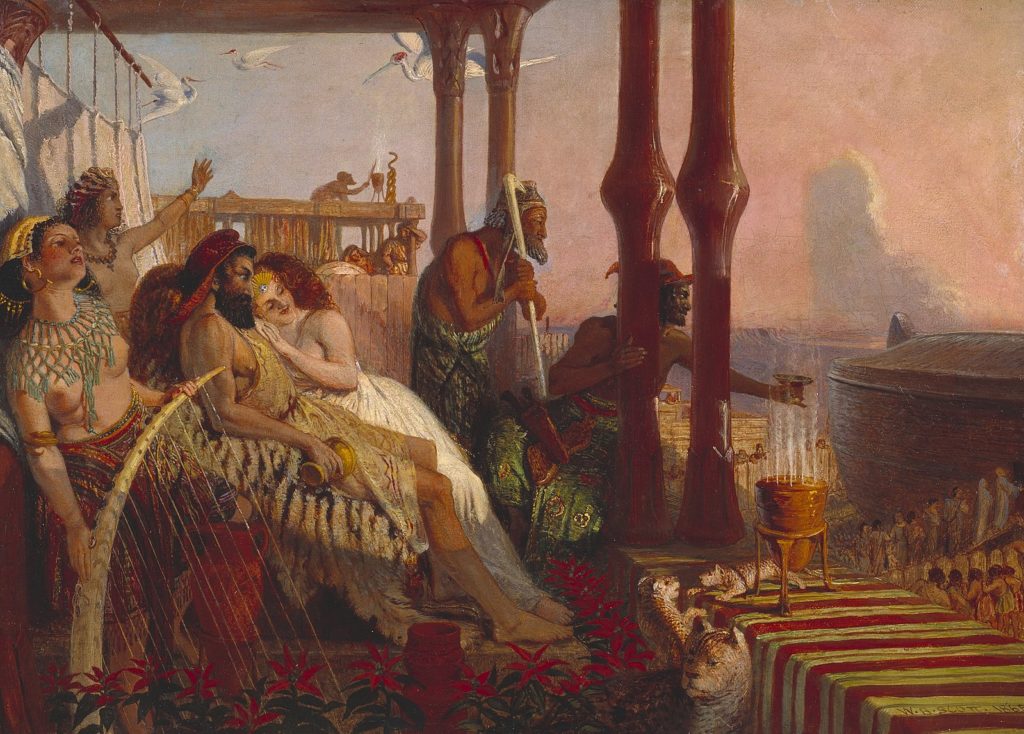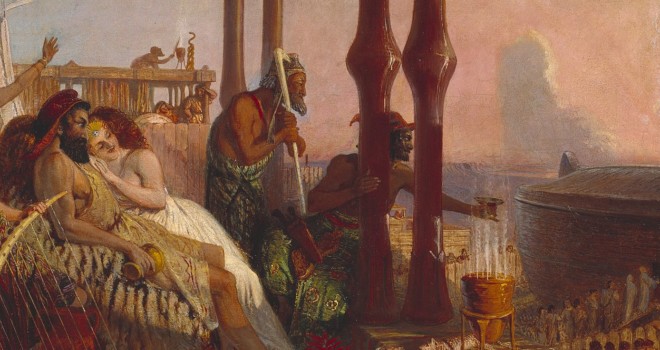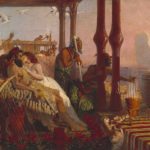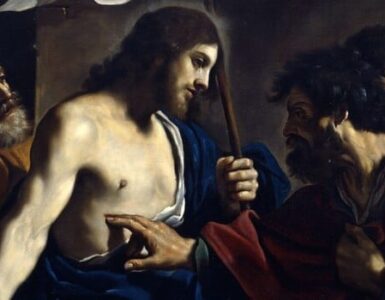Viewing and pondering sacred art offers the faithful a great way to prepare for the birth of Our Blessed Lord at Christmas. This series of articles will highlight several pieces of art related to the Gospel readings of this year’s lectionary cycle, as well as two pieces related to the week leading to Christmas. Each of these pieces of art allows us to reflect deeply on God’s plan for our lives, and to be prepared for the joyful celebration of Our Lord’s Nativity.
At the beginning of the Advent season, the Church calls us to evaluate our lives and our stance before God so that we are ready for the Parousia and Final Judgment. That’s why the Gospel for the first Sunday of Advent presents Jesus’ teaching about “the days of Noah” and the necessity of being prepared for the “coming of the Son of Man…at an hour you do not expect.” In response to this reality, Jesus’ startling exhortation is “Therefore, stay awake!” (Matthew 24:37-44) Jesus’ teaching was clearly meant to address the decadence that has been present in every age of human history, including his and ours. Guarding against such decadence, even overcoming it when it is present, is perhaps the most important effort that we can make during Advent, or any liturgical season.

The Eve of the Deluge, painted in 1865 by William Bell Scott, depicts quite well the contrast between faithfulness and decadence in “the days of Noah” that Jesus mentioned. Scott draws us into the moment when the biblical patriarch made a very countercultural decision to build and enter an ark, in preparation for a flood that seemed nowhere nigh, but had been promised by a relatively unknown God. While the historical setting is the ancient Near East, we must be aware that the moral setting might be our own bodies, minds, and souls. We must be aware that we might be living in “the days of Noah” as much as that generation.
At the middle-left of the painting, a kingly figure reclines on a chair covered with tiger skin, embraces a young woman who is only half-covered by a sheet, and holds an empty chalice. Around this king are multiple other symbols of decadence: cheetahs, considered an unclean animal in the Mosaic Law; red lilies, signifying the human passions; multiple bare-chested women in some kind of induced intoxication, one of whom has been playing music. The whole scene bears the imprint of sensuality. As he sits in this position, the king glares with disdain out over the balcony, smugly looking at the ark and its inhabitants. Immediately, a viewer feels quite acutely the dichotomy of this historical moment: placation of the senses in contrast to the faithfulness that leads to ridicule and social disdain.
Near the king, directly in the middle of the painting, are two men who are certainly priests of the local pagan religion. The elder priest looks out with sleepy puzzlement, while the younger priest with a more sinister face engages in some form of incense ritual. In the background, in another area of the royal palace, a shadowy figure also prays with incense next to a sculpted bronze snake. What are they worshiping? For what do they pray in these “days of Noah”? The effect of this scene, as the effect of the Gospel passage, is to get viewers to ask if something has taken the place of the One, True God as the object of our worship.
Near the top of the painting, above the palace veranda, storks circle in the sky. These birds are probably placed in the scene as a direct reference to a prophecy spoken by Jeremiah while he tried to warn Israel of their impending spiritual death by exile. “Even the stork in the heavens knows her appointed seasons,” Jeremiah exclaimed, “but my people know not the just decrees of the Lord” (Jer. 8:7). Since that time, the stork has been symbolic of the fate of an unfaithful people. Thus, storks can be a great reminder to us during Advent that we ought to guard against obstinance to God’s desires and commands.
On the right of the image, there is a red sky with a developing storm cloud. This might cause a viewer to recall Jesus’ words about red skies earlier in the Gospel: “You know how to interpret the appearance of the sky, but you cannot interpret the signs of the times” (Mt. 16:2-3). Anyone trying to live faithfully in decadent times needs to ask the Lord if there is any moral deluge coming into my life that would separate me from the Lord. If so, how will I prepare and overcome it, even if it is not socially acceptable?
Below the cloud is the ark that Noah and his sons constructed. When we see the ark, we ought to see it as the vessel that provides shelter from the storm and allows God’s covenant to move forward to the next generation. Throughout every generation since Noah, God’s chosen people, culminating in the Church, has been this vessel. This painting reminds us that in times of cultural decadence, as well as personal difficulty, we can seek refuge in the Church rather than drowning in our own troubles or the world’s decadence.
Near the entrance of the ark are two groups of people, both of which are fairly indistinct. Eight people are entering the ark, those who were faithful to God’s command. Other local citizens stand in a semi-circle and watch. Perhaps they are questioning. Perhaps they are ridiculing. In any case, they are part of the culture that cannot see the value of preparing and entering the ark. The fact that both of these groups are less clearly drawn creates a great question for Advent: am I living faithfully according to God’s commands, even if I don’t understand and if I become a social pariah? Or, do I stand by skeptically and cynically as others try to live faithfully? Do I judge others who have tried to read the signs of the times and act accordingly?
Scott’s painting and the Gospel for the First Sunday of Advent both draw us in to the perpetual problems of complacency and sloth. These were problems in “the days of Noah,” they certainly are problems in our world today, and they definitely can encroach in our own lives. Viewing this painting provides a fantastic reminder that any one of us can slide slowly out of right relationship with God if we get caught up in the decadence of our culture. It also serves to remind us that God’s judgment might be imminent at any time. Perhaps most importantly, The Eve of the Deluge, like Jesus’ words in the Gospel, ultimately helps each of us to prepare for the coming of the Lord and our individual judgment. For each of us, our judgment could mean that we are carried away by a deluge of self-love, or it could mean that we are welcomed into the Eternal Ark of Heaven.
Therefore, each of us will do well to ponder The Eve of the Deluge this Advent. Let’s hope it causes us to examine our lives for tendencies of complacency, decadence, and self-love. That will allow us to become more like Noah and less like the decadent culture around us. That will Advent to be a productive and fruitful season in our lives.
✠
The Eve of the Deluge is in the public domain.













